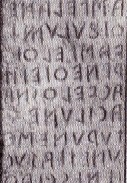Good morning!

This wonderful site has brought me a lot of enjoyment over quite a few years - my heartfelt "THANKS!!!!" to Michelle and the archaeologica-team for providing this fabulous service and their quest to further knowledge and understanding.
I hope you have room at your merry little round table for a fellow lover of all things history, who every once in a while, just like the blind chicken that finds a kernel of corn, feels she can provide an answer to a question... and that you won't hold my amateur status against me, if I make a mistake...

The language on the mosaic is Greek. The Greek language has changed a few times during the course of history, and I seem to remember that Linear A and Linear B are ancient predecessors to the Archaic Greek that evolved into the current, Modern Greek spoken today in Greece.
The location of the mosaic could be anywhere in the areas that were influenced by the conquests of Alexander the Great, but my best guess is that it is somewhere in Northern Greece, in ancient "Macedonia" (not to be confused with the current areas and countries that all lay claim to the name of "Macedonia" - that's a can of worms I'm not opening

).
This conclusion is based on the few words that I can positively decipher - second from last line reads "Pavlou tou theo fili kai filo..." and the last word "Makedon..." and the name "Romulos" on the right next to the figure under the wolf... among a few others...
Modern Greek (with disregard to even a semblance of grammar): Pavlou = Paul, tou = of, theo = god, fili = friends, kai = and, filo = friend...
The "f" in "filo" or "fili" is transcribed into English with a "ph"... as in philosophy, Philadelphia (the city of brotherly love; adelphos = brother), and the like...
The circle with the little star symbol above the wolf's tail looks like a stylized version of the Royal Macedon Sun symbol used by Phillip II and Alexander the Great. Excavations in ancient Olynthos (which was razed to the ground by Phillip II), Vergina (where a Royal Macedon tomb was found) and quite a few other sites in Northern Greece have produced magnificent mosaics, but due to the lack of funds, most have been covered up again to protect the artwork against the elements and vandalism. I don't know if this picture shows one of them, or if the mosaic is one found outside of modern-day Greece...
Aeneas, a hero of the Trojan War, is the reputed ancestor of the Romans...
Hmmm, this is pure speculation on my part (I'm not an expert

), but it it would appear that the owner of this mosaic was not only rich, but also boasted of connections to a royal household... for all the envious guests to see, when they show up for lavish entertainment at this dress-for-success venue... The ancient version of an expensive pad in Manhattan, with a doormat that reads "wipe your feet"...


Cheers!


